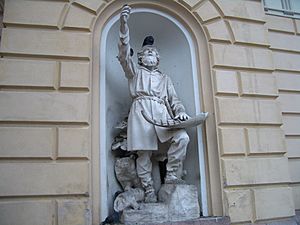Oral tradition facts for kids
An oral tradition is how people pass down knowledge, stories, and rules by talking and telling them. This happens from older generations to younger ones. It's a way to keep history and culture alive, especially in civilizations that didn't have a writing system. Imagine a grandparent telling their grandchild a story that their own grandparent told them! This is how oral traditions work.
A famous example is the ancient Greek poetry of the Iliad and the Odyssey. These epic stories were told and sung for many years before someone finally wrote them down.
Contents
What is Oral Tradition?
Oral tradition means sharing information by speaking or singing. It includes many things like folktales, myths, legends, songs, poems, and even laws. People remember and repeat these stories and facts, making sure they are passed on. This helps keep a community's history and values alive.
Why is Oral Tradition Important?
Oral traditions are super important for many reasons.
- Keeping History Alive: Before writing was common, oral traditions were the main way to remember past events. They told people about their ancestors and important moments.
- Sharing Knowledge: They passed down practical skills, like how to hunt, farm, or build. They also shared wisdom about life and nature.
- Building Community: Storytelling often brought people together. It helped them feel connected to their culture and each other.
- Teaching Values: Many stories taught important lessons about right and wrong. They showed what was valued in a society.
- Preserving Culture: Oral traditions are a big part of a group's identity. They include unique songs, dances, and ways of speaking.
How Does it Work?
People who are good at remembering and telling stories are often central to oral traditions. They might be elders, poets, or special storytellers. They learn the stories by heart and then perform them for others. Sometimes, the stories change a little over time as they are retold. This can add new details or adapt them to new situations.
Different Forms of Oral Tradition
Oral traditions come in many forms around the world.
- Folktales: These are popular stories that often teach a lesson or explain something about the world. They might feature animals, magical creatures, or everyday people.
- Myths: Myths are sacred stories that explain how the world began or why things are the way they are. They often involve gods, goddesses, or heroes.
- Legends: Legends are stories about real people or events from the past, but they often have some exaggerated or magical parts.
- Epic Poems: These are long, narrative poems that tell the adventures of heroes. The Iliad and Odyssey are famous examples.
- Songs and Chants: Music is a powerful way to remember and pass on stories or historical events. Many cultures have traditional songs that tell tales.
- Proverbs and Riddles: Short sayings or puzzles that carry wisdom or cultural knowledge.
Oral Tradition and Writing
Over time, many oral traditions were eventually written down. This helped preserve them even more. For example, the stories of the Bible were passed down orally for centuries before being written. The same happened with many ancient myths and epic poems from different cultures. Even today, some communities still rely heavily on oral traditions to share their heritage.
Images for kids
-
Filip Višnjić (1767–1834), Serbian blind guslar
See also
 In Spanish: Tradición oral para niños
In Spanish: Tradición oral para niños




